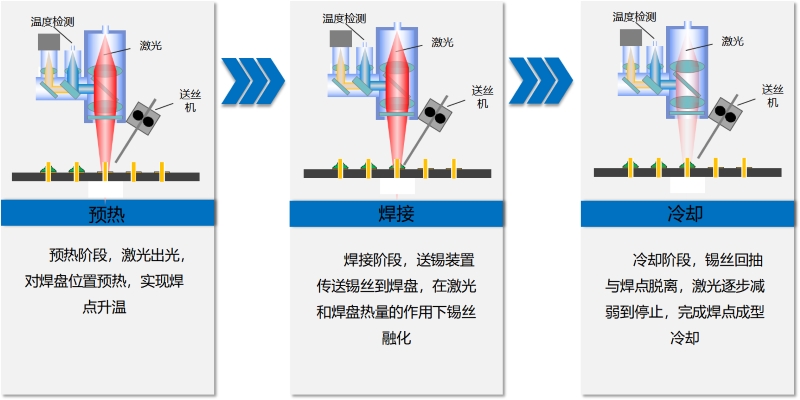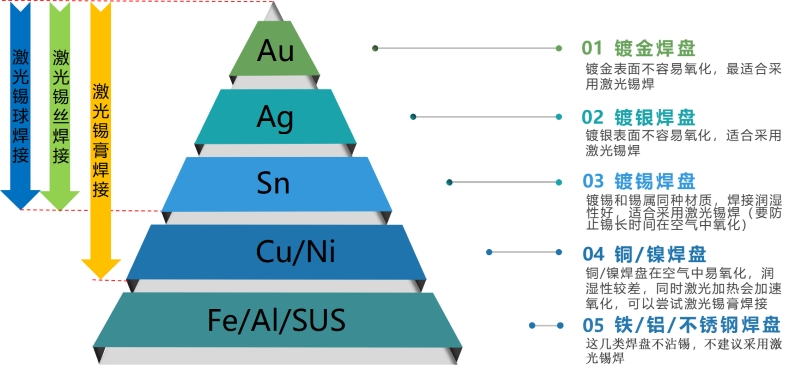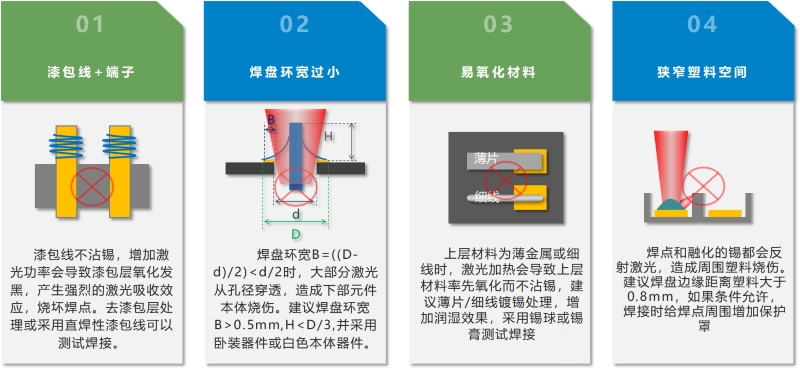Discussion on Suitable Material Structures and Design Recommendations for Laser Soldering
Before analyzing the key points mentioned above, let us briefly review the principle of laser wire soldering, which generally involves three stages: preheating → soldering → cooling.

Schematic Diagram of Laser Wire Soldering Process
Preheating Phase:
The laser emits light to preheat the pad area, gradually raising the temperature of the solder joint.
Soldering Phase:
The wire feeder delivers solder wire to the pad. Under the combined effect of laser heating and pad temperature, the solder wire melts and bonds to the pad.
Cooling Phase:
The solder wire retracts and separates from the joint while the laser gradually diminishes until complete shutdown, allowing the solder joint to cool and solidify.
Industry Application:
Within the 3C/5G consumer electronics sector, laser wire soldering has gained significant adoption among manufacturers. This is largely due to its broad compatibility with pads of varying specifications and dimensions, as well as its cost advantage over alternative methods like laser solder paste welding and laser ball soldering.

Comparison of Advantages: Laser Solder Wire vs. Paste vs. Ball Soldering
Laser Solder Ball Soldering:
Contact-free process
No flux required
Exceptional solder volume consistency
High-efficiency welding
Ideal for precision soldering applications
Laser Solder Wire Soldering:
Contact-free process
Eliminates soldering tip wear
Perfect for confined spaces where traditional soldering irons would interfere
Laser Solder Paste Soldering:
Contact-free process
Optimal for micro-solder joints
Effective for oxidation-prone materials
Specialized applications including through-hole soldering without component damage
Materials Suitable for Laser Soldering
Note that laser soldering has limitations - certain materials cannot be effectively soldered using this method, as illustrated below:

Diagram of Materials Suitable for Laser Soldering
Gold-plated, silver-plated, and tin-plated pads are most suitable for laser soldering and compatible with all three aforementioned soldering processes (wire, paste, and ball).
Copper/nickel pads tend to oxidize readily in air, resulting in poor wettability. Laser heating may accelerate oxidation - laser solder paste welding is recommended for these materials.
Iron/aluminum/stainless steel pads are not recommended for laser soldering due to their inherent non-wetting properties with solder.
Structures Suitable for Laser Soldering

Illustration of Structures Suitable for Laser Soldering
There are six common joint structures for laser soldering (as shown in the diagram):
Corner Joint
Overlap Joint
Sandwich Joint
Lap Joint
Through-hole Joint
Bridge Joint
Laser Soldering Design Recommendations
In daily soldering processes, prototype development involves working with diverse product types. For special cases, we have compiled four key recommendations:

Design Recommendations for Laser Soldering
In daily soldering processes, various product samples are encountered during prototyping. For special cases, we have compiled the following four key recommendations:
Illustration of Laser Soldering Design Recommendations
Enameled Wire + Terminal
Issue: Enameled wire is non-wettable. Increasing laser power may oxidize/darken the enamel, creating strong laser absorption that damages solder joints.
Solution: Remove enamel coating or use directly solderable enameled wire for testing.
Insufficient Pad Annular Ring Width
Issue: When ring width B=((D-d)/2)<d/2, most laser energy penetrates the hole, burning underlying components.
Solution: Maintain B>0.5mm and H<D/3. Use horizontally mounted or white-body components.
Oxidation-Prone Materials
Issue: Thin metals/fine wires oxidize rapidly under laser heating, becoming non-wettable.
Solution: Apply tin plating to thin sheets/wires. Test with solder balls or paste.
Constrained Plastic Spaces
Issue: Laser reflection from solder joints/molten solder burns surrounding plastic.
Solution: Keep >0.8mm clearance between pads and plastic. Use protective shields if possible.
Summary
With over two decades of specialization in laser soldering technology, Songsheng Optoelectronics possesses profound expertise in laser applications for industrial manufacturing, recognizing their unique and indispensable advantages. Our independently developed Constant-Temperature Precision Laser Soldering System embodies cutting-edge innovation and integrated technologies, delivering outstanding performance and reliability.
Technically, the system utilizes highly stable semiconductor lasers as its energy source to ensure consistent power output. Through advanced optical engineering, it achieves perfect coaxial alignment of four critical components - the laser beam, CCD imaging, temperature measurement, and guidance light - resolving alignment challenges between solder points, positioning markers, imaging focal points, and actual welding spots. This breakthrough eliminates complex calibration procedures while enabling ultra-precise microelectronics soldering. The proprietary feature-based positioning technology further enhances production yield for precision microelectronics manufacturing, and the system seamlessly integrates with large-scale production lines.
Contact: Mr.Xiao
Phone: +86-13385280662
E-mail: market001@whlaser.cn
Add: Room 02, Floor 5, Building 9, Gezhouba Sun City, No. 40, Gaoxin 4th Road, Donghu New Technology Development Zone, Wuhan